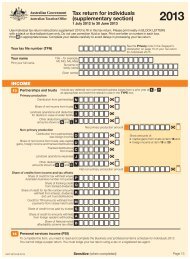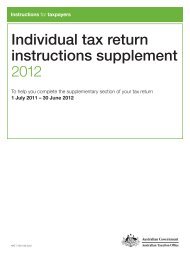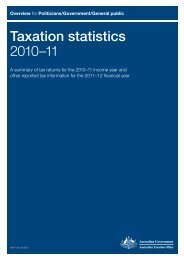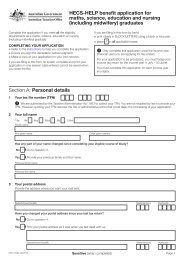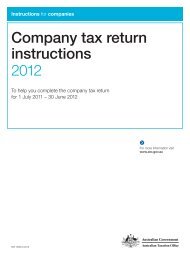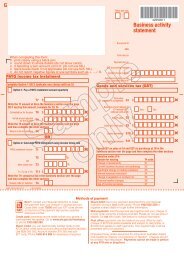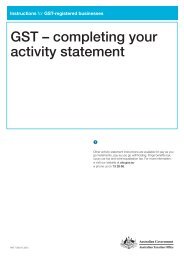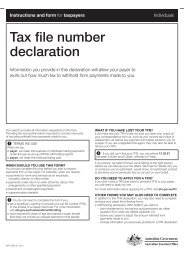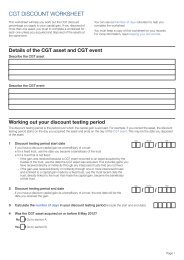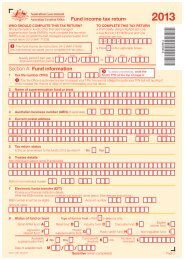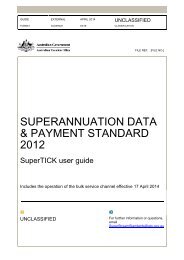Guide to depreciating assets 2013 - Australian Taxation Office
Guide to depreciating assets 2013 - Australian Taxation Office
Guide to depreciating assets 2013 - Australian Taxation Office
Create successful ePaper yourself
Turn your PDF publications into a flip-book with our unique Google optimized e-Paper software.
Used mainly <strong>to</strong> produce non-businessassessable incomeSome examples of <strong>depreciating</strong> <strong>assets</strong> used <strong>to</strong> producenon‐business income are:n a briefcase or <strong>to</strong>ols of trade used by an employeen freestanding furniture in a rental property, andn a calcula<strong>to</strong>r used in managing an investment portfolio.To claim the immediate deduction, you must use the<strong>depreciating</strong> asset more than 50% of the time for producingnon-business assessable income.If you meet this test, you can use the asset for otherpurposes (such as <strong>to</strong> carry on a business) and still claim thededuction. However, if you use the asset mainly for producingnon‐business assessable income but you also use the assetfor a non-taxable purpose, then the amount of deductionmust be reduced by the amount attributable <strong>to</strong> the use fora non‐taxable purpose.EXAMPLE: Depreciating asset used mainly<strong>to</strong> produce non-business assessable income,ignoring any GST impactRob buys a calcula<strong>to</strong>r for $150. The calcula<strong>to</strong>r is used40% of the time by him in his business and 60% of thetime for managing his share portfolio. As the calcula<strong>to</strong>ris used more than 50% of the time for producingnon‐business assessable income, Rob can claim animmediate deduction for it of $150.If Rob used his calcula<strong>to</strong>r 40% of the time for privatepurposes and 60% of the time for managing his shareportfolio, he is still using the calcula<strong>to</strong>r more than 50%of the time for producing non-business assessableincome. However, his deduction would be reducedby 40% <strong>to</strong> reflect his private use of the asset.Not part of a setYou need <strong>to</strong> determine whether items form a set on a caseby-casebasis. You can regard items as a set if they are:n dependent on each othern marketed as a set, orn designed and intended <strong>to</strong> be used <strong>to</strong>gether.It is the cost of a set of <strong>assets</strong> you acquire in the income yearthat must not exceed $300. You cannot avoid the test bybuying parts of a set separately.EXAMPLE: Set of items, ignoring any GST impactIn the 2012–13 income year, Paula, a primary schoolteacher, bought a series of six progressive reading bookscosting $65 each. The books are designed so that pupilsmove on <strong>to</strong> the next book only when they have successfullycompleted the previous book. The books are marketedas a set and are designed <strong>to</strong> be used <strong>to</strong>gether. The sixbooks would be regarded as a set. Paula cannot claim animmediate deduction for any of these books because theyform part of a set which she acquired in the income year,and the <strong>to</strong>tal cost of the set was more than $300.EXAMPLE: Not a set, ignoring any GST impactMarie, an employee, buys a range of <strong>to</strong>ols for her <strong>to</strong>ol kitfor work (a shifting spanner, a boxed set of screwdriversand a hammer). Each item costs $300 or less. While the<strong>to</strong>ols add <strong>to</strong> Marie’s <strong>to</strong>ol kit, they are not a set. It wouldmake no difference if Marie purchased the items at thesame time and from the same supplier or manufacturer. Animmediate deduction is available for all the items, includingthe screwdrivers. The screwdrivers are a set as they aremarketed and used as a set. However, as the cost is $300or less, the deduction is available.A group of <strong>assets</strong> acquired in an income year can be a setin themselves even though they also form part of a larger setacquired over more than one income year. If the <strong>assets</strong> acquiredin an income year are a set then the <strong>to</strong>tal cost of that set mustnot exceed $300. Assets acquired in another income yearthat form part of a larger set are not taken in<strong>to</strong> account whenworking out the <strong>to</strong>tal cost of a set and whether items form a set.EXAMPLE: Set of items part of a larger set,ignoring any GST impactIn the 2012–13 income year, Paula, a primary school teacher,hears about a series of 12 progressive reading books. Thebooks are designed so that pupils move on <strong>to</strong> the next bookonly when they have successfully completed the previousbook. The first six books are at a basic level while the secondsix are at an advanced level.Paula buys one book a month beginning in Januaryand by 30 June <strong>2013</strong> she holds the first six books (thebasic readers) at a <strong>to</strong>tal cost of $240. Because of theinterdependency of the books, the six books are a set eventhough they can be purchased individually and they formpart of a larger set. An immediate deduction is available foreach book because the cost of the set Paula acquired duringthe income year was not more than $300.If Paula acquires the other six books (the advanced readers)in the following income year, they would be regarded as aset acquired in that year.The concept of a set requires more than one <strong>depreciating</strong>asset. In some cases, however, more than one item maybe a single <strong>depreciating</strong> asset. An example would be athree‐volume dictionary. This is a single <strong>depreciating</strong> asset,not a set of three separate <strong>depreciating</strong> <strong>assets</strong>, as the threevolumes have a single integrated function.Not one of a number of identicalor substantially identical itemsItems are identical if they are the same in all respects. Itemsare substantially identical if they are the same in most respectseven though there may be some minor or incidental differences.Fac<strong>to</strong>rs <strong>to</strong> consider include colour, shape, function, texture,composition, brand and design.The <strong>to</strong>tal cost of the asset and any other identical orsubstantially identical asset that you acquire in the incomeyear must not exceed $300. Do not take in<strong>to</strong> account <strong>assets</strong>that you acquired in another income year.10 a<strong>to</strong>.gov.au GUIDE TO DEPRECIATING ASSETS <strong>2013</strong>



